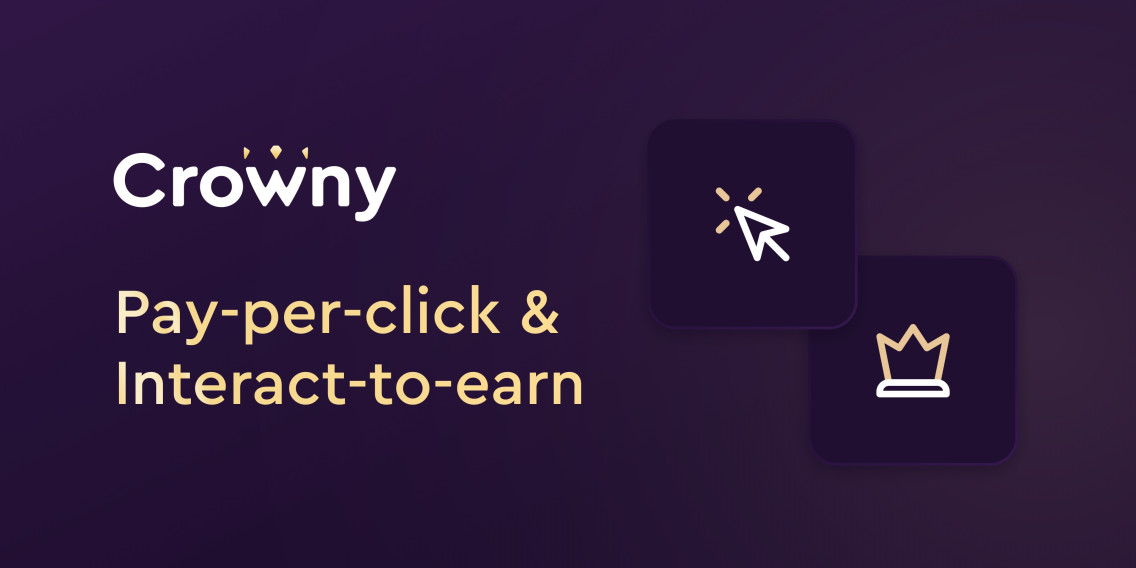Pay-per-click is a commonly used advertising model. Interact-to-earn is a brand-new method that tackles some of the problems PPC advertisers face.
Table of contents
☑️ Pay-per-click definition and how it works
☑️ Interact-to-earn definition and how it works
☑️ Differences & similarities between PPC & I2E
☑️ Pay-per-click & interact-to-earn model purposes
What is pay-per-click?
PPC, or pay-per-click marketing, is an advertising model. In internet marketing, advertisers can promote a page using this model. When advertisers place an ad using this model, a fee is paid to the host of the advertisement platform once the PPC ad has been clicked. The model is used on various online marketing platforms. Think of social media, search engines, websites with display ads and more. A commonly used form of advertising with this model is SEA or Search Engine Advertising. The top results you will find on Google are an example of this. You can recognize these sponsored results by the advertisement label next to them. Users of search engines are becoming increasingly aware of the ads in search engines, and are even starting to develop a certain aversion. Research recently indicated that 94% of people skip search engine ads.
94% of people skip search engine ads - Wordstream
How does PPC work?
So whenever a user clicks an advertisement, advertisers pay a fee. The visitor lands on the landing page, which is the destination that’s connected to the ad. A good pay-per-click campaign concludes with a positive ROI, the return on investment. The total amount of fees for all the clicks should cost less than the summed-up value of all conversions generated by the campaign. It’s also advisable to take the time and effort into account that has been invested in this campaign in order to specify a more accurate ROI. The costs of this model are determined in various ways. For example, in search engines there often is an auction per keyword depending on factors such as the bid amount. In other words, it’s based on the demand or amount of competitors for this specific keyword. The quality of the search ads also plays a role in deciding who’s getting the top position on search engine result pages.
90% of all pay-per-click ad campaigns on Google and Bing are affected by click fraud - ClickCease
What is interact-to-earn?
Interact-to-earn is a new model in the customer loyalty & marketing industries, inspired by the disrupting Web3 movement started by Ethereum founder, Gavin Wood. On Crowny’s platform, marketers can launch campaigns which are visible in the mobile app. Marketers are able to schedule interactive campaigns such as one-click reviews. They reach their community using push notifications and/or QR codes. Using the interact-to-earn model, the receiver of the push notification receives a small reward for interacting with the content. This results in a higher clickthrough rate and positive brand perception. The platform logically charges a fee per generated interaction. Interact-to-earn is a model that is exclusively being used by Crowny's platform and its brand-new app. This performance-driven Solana app is used as a content distribution platform in which brand communities get onboarded. Once onboarded, app users are able to connect and interact with their favorite brands.
Read up on Crowny’s latest Web3 software development here.
How does I2E work?
With interact-to-earn, brands are able to combine content marketing with a rewards system that stimulates engagement. This enables increased quality interactions with online communities that are receptive to the messaging and willing to provide input. Brands can launch a campaign on the platform in two ways, with the most important one being a loyalty campaign. Partner brands keep their online communities up-to-date and reward them for staying engaged on a regular basis. As a result, strong relationships with repeat purchases and increased customer lifetime values will be developed quicker than ever before. There are a couple of advantages to the interact-to-earn model which can drive up the ROI of a campaign. An example is blockchain-based rewards: brands reward their community efficiently, fast, safe, and sustainable using tokenized economies built on blockchain technology. The low costs and limitless scalability ensure that the model, in combination with the platform, is a future-proof solution for any business.
Pay-per-click & interact-to-earn
What are the differences and similarities?
High-budget PPC campaigns with a demonstrated strategy can generate a lot of conversions, there’s no doubt about that. Except there’s no relationship being built between the consumer and the brand, with no focus on building lasting customer loyalty whatsoever. This is significant since increasing customer retention by 5% boosts profits by 60% on average! This is why pay-per-click campaigns will, more often than not, generate one-time conversions. With interact-to-earn, there is a lot of interaction over various touch points between the brand and the consumer. Genuine bonds between brand and consumer will be built. For brands, this results in increased customer lifetime values and overall revenue. Consumers will always stay up-to-date with the brand they love, knowing exactly what new products, events, and exclusive offers they can benefit from.
Increasing customer retention by 5% boosts profits by 25% to 95%. - Retentionscience
Google generates a lot of revenue, while consumers are the ones that create value. Now more than ever. In these modern times, consumers generate value in many more ways than before. They give feedback, generate data, engage with brands and when the brands are doing a well-enough job, the consumers even spread the word. As for all marketers now, word-of-mouth marketing is the best form of marketing. So why not stimulate customers to spread the word more often by giving something in return?
Did you know that companies that spend $10,000 on Google Ads per month lose an estimated $12,000-$15,000 annually due to click fraud? - Clickcease
By rewarding consumers through incentive-driven interactions, businesses benefit in multiple ways. Think of increased brand value, brand trust, retention rates, brand advocates, etc. Partially through these incentive-driven interactions, Crowny aims to revolutionize consumer-business relationships. To reward users and businesses for every interaction, that’s the mission. By monetizing community engagement and democratizing the created value, the marketing- and customer loyalty industries can expect a new kid on the block. Brands can experience all loyalty program benefits using branded loyalty programs and campaigns on Crowny’s platform.
Pay-per-click & interact-to-earn model purposes
Conclusion
Simply put, the pay-per-click model is an advertising method. The main goal of a PPC campaign is to reach new customers in the relevant phase of the customer journey and convert them as quickly as possible. When a PPC campaign gets enough attention from a marketer with the right skill set and vision that fit the business, a pay-per-click campaign can do really well in achieving its goal.
The interact-to-earn model is an incentive-driven engagement method. Rather than focusing on attracting new customers and generating as many one-time conversions as possible, this method focuses on retaining the customers and creating an intimate lasting relationship that generates long-term revenue growth.
Both methods serve their purpose. They are alike in some areas, in others they are not. Together, they could make a good team. Marketers of the future could use a pay-per-click campaign to attract new customers, and an interact-to-earn campaign to retain them.
Make your community thrive
Be one of the first brands to use the interact-to-earn model.
Aim your marketing efforts where they should be aimed at. Grow your user base, maximize customer retention and increase revenue for years to come with Crowny.
Interested in a demo? Get early access here.

